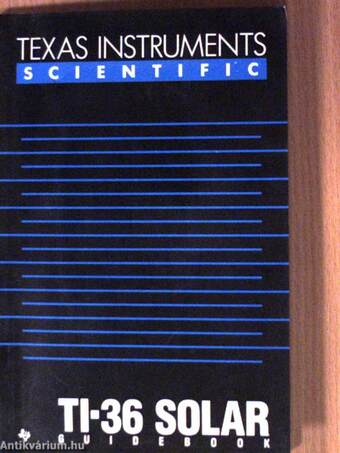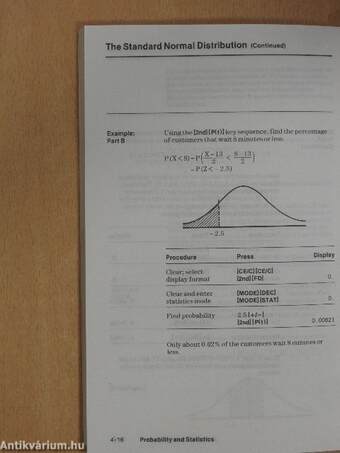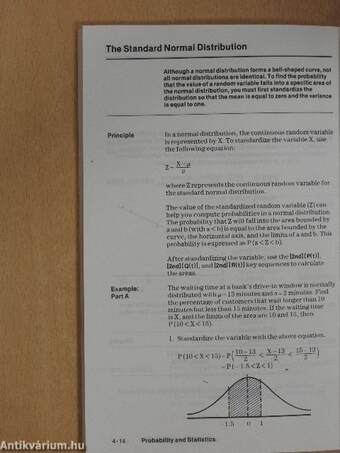1.116.716
kiadvánnyal nyújtjuk Magyarország legnagyobb antikvár könyv-kínálatát
Texas Instruments Scientific TI-36 Solar
Guide Book/Használati útmutató
| Kiadó: | Texas Instruments Incorporated |
|---|---|
| Kiadás helye: | Texas |
| Kiadás éve: | |
| Kötés típusa: | Ragasztott papírkötés |
| Oldalszám: | 155 oldal |
| Sorozatcím: | |
| Kötetszám: | |
| Nyelv: | Angol |
| Méret: | 21 cm x 14 cm |
| ISBN: | |
| Megjegyzés: | Használati útmutató. Fekete-fehér ábrákkal. További kapcsolódó személyek a kötetben. |
naponta értesítjük a beérkező friss
kiadványokról
naponta értesítjük a beérkező friss
kiadványokról
Előszó
Operating the Calculator
Introduction The TI-36 SOLAR calculator is designed to perform
many advanced operations that are useful in math and
science at both the high school and college levels.... Tovább
Előszó
Operating the Calculator
Introduction The TI-36 SOLAR calculator is designed to perform
many advanced operations that are useful in math and
science at both the high school and college levels.
Because the calculator is solar-powered, you never need
to replace batteries. You can use the calculator
wherever there is an adequate light source, indoors or
outdoors.
Chapter 1 explains all the features and keys on the
calculator. Step-by-step instructions and examples help
you learn to perform calculations quickly and easily.
Some of the topics covered in this chapter are:
> AOS™ Algebraic Operating System
> Standard math keys
> Trigonometric keys
> Hyperbolic function keys
> Binary, octal, and hexadecimal modes
> Complex number mode
> Statistics mode
The remaining chapters include examples that show
you how to use the Calculator to solve problems in
trigonometry, physics, probability, and statistics. By
helping you to solve a wide variety of problems, the
TI-36 SOLAR calculator can meet your needs as a high
school or college student and continue as a valuable tool
into your career. Vissza
Tartalom
Table of Contents
Chapter 1:
Operating the
Calculator
Introduction
Turning the Calculator On and Off
Clearing the Calculator
[CE/C]-Clear Entry/Clear Key
lACl-All Clear Key
The Keyboard
[I NVl—Inverse Function Key
[2nd]—Second Function Key
[MODE]—Mode Key
The Display
Display Indicators
Display Formats
[2nd] [FD]—Floating-Decimal Notation Key Sequence
[2nd] [Sei]—Scientific Notation Key Sequence
[2nd] [Engl—Engineering Notation Key Sequence . . .
[2nd] [Fix]—Fixed-Decimal Key Sequence
Changing Display Formats
Data Entry Keys
[ 0 ]-[ 9 ]—Digit Keys
[. ]—Decimal Point Key
[+/-]—Change Sign Key
[2nd] [it]—Pi Key Sequence
[2nd] [Rnd]—Random Number Key Sequence
[ a ], [ b ]—a and b Data Keys
[EXP]—Exponent Entry Key
Memory Operations
[STO]—Store Key
[RCLl—Recall Key
[2nd] [EXC]—Exchange Key Sequence
[SUMl—Sum Key
AOS™ Algebraic Operating System
Purpose of AOS System
Algebraic Hierarchy
Pending Operations
Parentheses
[(],[) ]—Parenthesis Keys
Correcting Entry Errors
[CE/C]-Clear Entry/Clear Key
[2nd] [x5y]—x Exchange y Key Sequence
Correcting Numbers and Immediate Functions
Correcting Pending Operations
Arithmetic and Factorial Keys
[ + ],[-],[ x ],[ -r ],[ = ]—Arithmetic Keys
[2nd] Ix! 1—Factorial Key Sequence
M
1-2
1*3
Chapter 1: Reciprocals, Powers, and Roots 1-29
Operating the [1/x]-ReciprocalKey 1-29
Calculator lx2l-Square Key 1-29
(Continued) [2nd] IVx ]—Square Root Key Sequence 1-29
[2nd] RGc ]—Cube Root Key Sequence 1-29
[ yx ]-—Universal Power Key 1*30
[INV][y*]-Universal Root Key Sequence 1-31
Constant Calculations 1*32
Setting the Constant 1-32
Logarithmic Keys 1 • 33
[Inx], [log]—Logarithm Keys 1 • 33
[INV] [ Inx], [INV] [log]—Antilogarithm Key Sequences .1-33
Percentage Calculations 1*34
[2nd] [%]—Percent Key Sequence 1-34
Combinations 1*36
[2nd] [nCr]—Combination Key Sequence 1-36
Permutations 1*37
[2nd][nPr]—Permutation Key Sequence 1*37
Angle Mode Selection 1 • 38
Angle Units 1-38
[DRG]—Angle Mode Change Key 1-39
[2nd] [DRG >]—Angle Conversion Key Sequence 1 • 39
Trigonometric Functions 1 • 40
[sin], [cos], [tan]—Trig Keys 1-40
[INV] [sin], [INV] [cos], [IN V] [tan]—
Inverse Trig Key Sequences 1*40
Hyperbolic Functions 1 • 42
[hyp]—Hyperbolic Key 1-42
Polar/Rectangular Conversions 1 • 44
Coordinate Systems 1*44
[2nd] [P^R]—Polar to Rectangular Conversion
Key Sequence 1*45
[2nd] [R^P]—Rectangular to Polar Conversion
Key Sequence 1*45
Deg/Min/Sec and Decimal Degrees Conversions 1-48
Degrees, Minutes, and Seconds 1*48
Decimal Degrees 1 • 48
[2nd] [> DMS], [2nd] [^DDl-DMS and DD Conversion
Key Sequences 1*48
Number System Modes 1 • 50
[MODE] [DEC]—Decimal Mode Key Sequence 1-50
[MODE] [BIN]-Binary Mode Key Sequence 1-50
[MODE] [OCT]-Octal Mode Key Sequence 1-50
[MODE] [HEX]-Hexadecimal Mode Key Sequence. . . . 1-51
Two' s Complement 1*51
Number System Notations 1*51
(continued)
Table of Contents (Continued)
Chapter 1:
Operating the
Calculator
(Continued)
Chapter 2:
Calculator
Trigonometry
Performing Binary Calculations
Entering Binary Numbers
Performing Octal Calculations
Entering Octal Numbers
Performing Hexadecimal Calculations
Entering Hexadecimal Numbers
Performing Mixed-Mode Calculations
Complex Number Mode
[MODE] [CPLX]—Complex Number Mode
Key Sequence
Complex Numbers
Entering Complex Numbers
Complex Arithmetic
Statistics Mode
[MODE] [STAT]—Statistics Mode Key Sequence . .
Clearing the Statistical Registers
[I + ], [2nd] [I - ]—Data Entry and Removal Keys
[2nd] [ n ]—n Key Sequence
[2nd][lx]—Sum of x Key Sequence
[2nd] [ I x2 ]—Sum of Squares Key Sequence
[2nd] [ "x ]—Data Mean Key Sequence
[2nd] [On], [2nd] [On-i]—Standard Deviation
Key Sequences
Performing Statistical Calculations
Entering Statistical Data
Analyzing the Data
Normal Distribution Keys
Normal Distribution
Standard Normal Distribution
[2nd] [P(t)] —Normal Distribution Key Sequence .
[2nd] [R( t)]—Normal Distribution Key Sequence
[2nd] [Q( t)]—Normal Distribution Key Sequence
Introduction 2. i
Pythagorean Theorem 2.2
Distance Formula
Law of Sines
Law of Cosines
Trig and Land Area 2.
Everyday Trig
Catenaries
2
2
2-4
2-5
2-6
8
10
12
Chapter 3: Introduction 3-1
Physics and The Speed of Light 3*2
Engineering Constant Acceleration 3*4
Free Fall 3-6
Kinetic and Potential Energy 3*8
Circular Motion 3-9
Universal Gravitation 3*10
Work and Power 3*12
Vectors and Force 3*14
Conservation of Momentum 3*16
Energy and E = mc2 3*18
Simple Lenses 3-20
Gas Laws 3*21
Avogadro'sLaw 3*22
Radioactive Decay 3*24
Ohm's Law and Parallel Resistance 3*27
Alternating Current Circuits 3*28
Series Resonance Circuits 3*29
Chapter 4: Introduction 4-1
Probability and Selecting a Random Sample 4-2
Statistics Statistically Analyzing Data 4*4
Linear Regression 4*6
The Standard Normal Distribution 4*14
Chapter 5: Introduction 5-1
Appendixes Appendix A: Number Systems 5*2
Appendix B: Error Conditions 5-6
Appendix C: Accuracy Information 5*9
Appendix D: In Case of Difficulty 5-10
Appendix E: Suggestions from Customers 5-11
Appendix F: Service Information 5 • 12
Appendix G: One-Year Limited Warranty 5*16
AppendixH: Index 5*17
Témakörök
Megvásárolható példányok
Nincs megvásárolható példány
A könyv összes megrendelhető példánya elfogyott. Ha kívánja, előjegyezheti a könyvet, és amint a könyv egy újabb példánya elérhető lesz, értesítjük.






